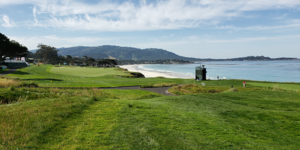Winter diseases in bermudagrass putting greens
The adoption of ultradwarf bermudagrasses (Cynodon dactylon X C. transvaalensis) by the golf course industry in regions where bermudagrass can be cultured on putting greens has been a “home run.” In the hands of skilled superintendents, these grasses make outstanding putting surfaces.
Since the introduction of ultradwarf cultivars, many conversions of older bermudagrass cultivars or creeping bentgrass (Agrostis stolonifera) greens to one of the ultradwarf cultivars have taken place in southern states, even well into the cooler Transition Zone environments. Superintendents and others have had to re-learn some lessons concerning their culture and maintenance with regard to disease occurrence.
For instance, when planted on sandy root zones with relatively high ‘perc’ rates, the turf of course is more prone to drought. The ultradwarf bermudagrasses, including TifEagle, Champion and MiniVerde, generally have a shallower root system than does TifDwarf. That fact also increases the risks of drought and occurrence of hydrophobic zones, such as localized dry spots. When root-active pathogens such as Gaeumannomyces graminis var. graminis (a pathogenic component of “bermudagrass decline”) or plant parasitic nematodes are present, it transforms a weakness into a liability that superintendents must recognize. Even diseases that are active on leaves, such as dollar spot (Sclerotinia homoeocarpa) and leafspot (Bipolaris cynodontis) can occur at higher levels when root zones are dry and nutrient uptake is reduced.
One suggestion to reduce the impact of these diseases is to plant these grasses in root zones that hold moisture and nutrients a little stronger, such as a mix containing 3 percent to 5 percent field soil by volume, as long as testing shows this to be a good compromise and drainage still is considered adequate.
Management of these grasses is relatively intense and requires close attention to routine and consistent cultural practices in order to manage organic matter. Through about the mid-2000s, these greens routinely were overseeded with Poa trivialis (rough bluegrass), primarily for winter play and color. Rough bluegrass also provided an excellent putting surface over the bermudagrass base. However, for the past several years, more and more courses are opting to not overseed but instead are using turf colorants for winter color. Use of turf colorants is an art and a science, and this practice generally has been successful as an alternative to overseeding.
However, winter diseases in ultradwarf bermudagrass greens can be quite damaging and highly visible. When greens are overseeded with cool-season grasses, any ills that might occur on bermudagrass are mostly masked in the winter months. On the cool-season turf overseedings, primarily dollar spot, occasional Pythium blight (Pythium spp.) and perhaps brown ring patch (Waitea circinata var. circinata) could occur, especially during spring transition. At times, microdochium patch (Michrodochium nivale) occurs in cold, wet conditions on Poa trivialis overseedings. This generally is easily controlled with fungicides such as chlorothalonil or iprodione. These diseases are dependent on specific environmental conditions, particularly abundant moisture and prolonged favorable temperatures, and their occurrence generally is acute and not chronic.
However, with the elimination of overseedings in recent years, diseases are much more noticeable and perhaps even more damaging because of increased stress on the turf itself without the cushioning effects of overseedings. The primary winter and spring diseases of ultradwarf bermudagrass are leaf spot (Bipolaris cynodontis), spring dead spot (Ophiosphaerella korrae and O. herpotricha), Pythium blights and root rots and microdochium patch.
Michrodochium patch
Michrodochium patch may be the most common and chronic of these diseases on bermudagrass greens. It has been known for many years as a pathogen of bermudagrass and many other grasses, but was not considered to be of much importance until recently, when its effects have been noted on greens not overseeded. Pathologists are re-examining it as a serious pathogen when weather conditions are cold, wet and prolonged.
One reason it may be common and chronic is that the organism can cause noticeable disease under a wide range of canopy temperatures. Ideally, the disease is most severe from freezing temperatures through the mid-40s F, but it can persist and even be active when temperatures are in the 60s. Turf recovery is not an option when bermudagrass is dormant or semi-dormant, so symptoms from an uncontrolled outbreak can persist for months and provide voids in the turf that affect putting and promote thinned turf that is prone to algae infestations.
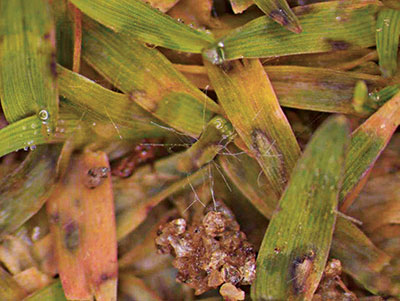
Water-soaked lesions and initial mycelium development of microdochium patch in bermudagrass.
Symptoms of microdochium patch can resemble initial Pythium blight or even leaf spot symptoms. Microdochium patch generally is most likely to occur on turf not protected by fungicides during cold, wet weather. It initially begins as small, water-soaked patches an inch or so in diameter, but can increase in size to patches up to a foot or more in diameter as patches coalesce. These symptoms closely resemble those that occur in cool-season grasses, but are not as distinct. Water-soaked patch margins are quite visible during active disease in cool-season grasses but may require a hand lens or microscope to notice in bermudagrass leaves (Fig. 1).
Many fungicides are labeled for michrodochium patch, although labels may mention synonymous names for the disease, such as fusarium patch or even pink snow mold. Fungicides likely control michrodochium patch best when the turf is still growing and can still recover from damage, conditions occurring only in early fall or during spring transition. In winter, if the turf is dormant, the fungus may be controlled, but if damage has occurred it likely will be visible until turf can grow and recover. In cool-season grasses, michrodochium patch is promoted by excess nitrogen fertilization going into winter, high soil pH and thatchy turf. Most ultradwarf greens are not fertilized at high levels, especially in the fall and winter, but higher soil pH levels might be a factor that could promote the disease. These questions await needed research in bermudagrass greens.
Spring dead spot
The Compendium of Turfgrass Diseases, Third Edition, states “Spring dead spot is the most important disease of Cynodon dactylon and Cynodon hybrids in North America and Australia.” Research recently conducted by Alejandro Canegallo and me shows that we can add Argentina and Uruguay to that list. Certainly that is true in U.S. Transition Zone environments, as the spring dead spot (SDS) symptoms appear during spring green-up after winter dormancy (Figure 2).
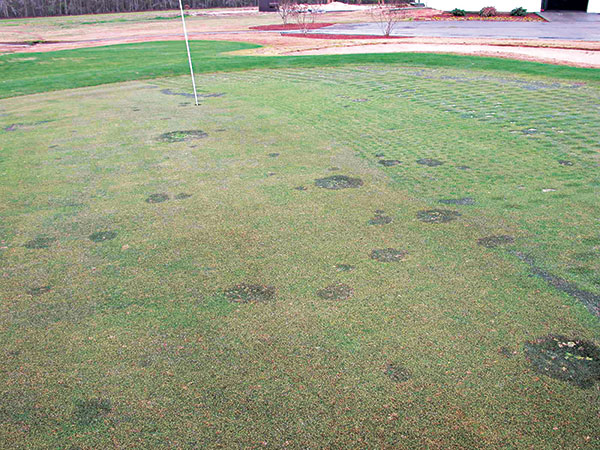
Spring dead spot in ultradwarf bermudagrass green at spring green-up.
If bermudagrass greens are cultured in semi-tropical or tropical environments the disease does not occur, and only sporadically occurs in the cooler part of the semi-tropical region. This is because the fungi capable of causing SDS infect the roots of bermudagrasses and colonize cortical and stele tissues thoroughly in susceptible grasses, weakening them such that they have poor survival after cold winters. Bermudagrasses that have been developed specifically for better low-temperature tolerance (e.g. Patriot, Latitude 36 and others most recently out of Oklahoma State University) have also been shown to have better tolerance to SDS. None of the currently cultured ultradwarf bermudagrasses were developed for low-temperature tolerance, and all are quite susceptible to SDS when cultured in environments where they go winter dormant or semi-dormant.
Major progress in the identification and understanding of SDS causal agents and their occurrence has occurred over the past two and a half decades. It is now accepted that the disease can be caused by any of three species of Ophiosphaerella: O. korrae, O. herpotricha and O. narmari. The development and use of specific DNA primers for each of these potential causal agents, and tools such as real-time PCR, have provided the means to identify these agents from infected roots without having to culture them in artificial media. These and other tools have led to the ability to effectively survey large numbers of SDS infection centers to determine the diversity of existing causal agents.
This research has confirmed that O. herpotricha is rare in the southeastern United States but occurs with higher frequency in Oklahoma, Kansas and Missouri. O. korrae is the primary pathogen in the southeastern U.S. Ophiosphaerella. narmari is rare in the United States but occurs in California. It has recently been shown that the cause of SDS in Argentina and Uruguay appears to be solely due to O. herpotricha.
Additionally, research conducted at North Carolina State University suggests that knowledge of the specific causal agent at a site may be important. Researchers there studied the effects of fertilizing with ammonium sulfate versus calcium nitrate on SDS caused by either O. korrae or O. herpotricha. In a three-year study, plots inoculated with O. herpotricha had less disease when fertilized with ammonium sulfate (an acidifying fertilizer), while disease in plots inoculated with O. korrae was not suppressed with ammonium sulfate but was suppressed with calcium nitrate. Additional research is needed on this topic, which opens the potential for real suppression of disease without the use of fungicides, an attractive prospect on fairways.
Spring dead spot has not been unknown in older cultivars of hybrid bermudagrasses such as Tifgreen and TifDwarf. However, the use of fenarimol (Rubigan) for Poa annua control in overseeded bermudagrass putting greens put SDS out of sight and eventually out of mind.
Rubigan was the best material for control of Poa annua in bermudagrass greens when applied in a series of applications prior to Poa annua germination. Rubigan also is a good fungicide for SDS, and application timing for both SDS and Poa control coincides in late summer and fall. In fact, in multiple trials conducted by several researchers, Rubigan was the most efficacious of the labeled fungicides for SDS.
However, a couple of factors led to some dramatic outbreaks of SDS in ultradwarf bermudagrass putting greens. One factor was that superintendents began using alternative methods to control Poa annua, such as sulfonylurea herbicides, instead of Rubigan. The other factor was that some single-component fungicides, which are labeled for SDS, have limited efficacy and include azoxystrobin, fluoxastrobin and thiophanate methyl.
Rubigan has been discontinued for sale, and only existing stocks can be used until depleted. This has increased the reliance on other chemistry such as formulations of tebuconazole (Torque 3.6SC, Mirage 2SC), which have performed moderately for SDS control on greens compared to Rubigan but have been improved in mixtures with thiophanate methyl. Trials at Clemson in multiple years have shown good suppression of SDS with Headway (azoxystrobin + propiconazole) at 3 oz. per 1,000 sq. ft. alternated with Briskway (azoxystrobin + difenoconazole). We have also seen in several trials that two of the new SDHI fungicide products, Velista (penthiopyrad) and Lexicon (a combination of pyraclostrobin and fluxapyroxad), have provided excellent SDS control during the past two years. This brings about the possibility of having fungicides available with high efficacy for SDS and without the baggage of growth regulation from certain DMI fungicides.
Superintendents managing bermudagrass greens in environments where SDS can occur should have new tools at this time to manage the disease, even on newly established greens where turf is not completely mature and where options with DMI fungicides are less desirable.
Leaf spot diseases
Leaf spot diseases on ultradwarf bermudagrasses can be caused by up to three or more species of Bipolaris: B. cynodontis, B. spicifera or B. sorokiniana. In recent work, the most commonly encountered pathogen in the southern states appears to be B. cynodontis (Figure 3). Leaf spot most often is noted in cooler seasons, when the growth of bermudagrass slows, such as in the fall in the Transition Zone or fall, winter and spring in states such as Florida. It is a chronic disease promoted by low fertility levels, increased thatch, dry root zones and humid turf canopies. In other words, conditions closely mimicking those that promote dollar spot. It’s not uncommon to find both diseases active in a turf stand in fall months.
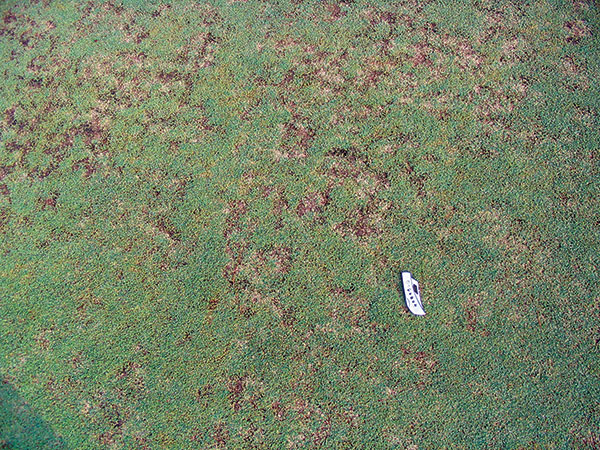
Leaf spot on an ultradwarf bermudagrass green.
Leaf spot and other cool-weather diseases have become more important in recent years. The elimination of overseeding with cool-season grasses has provided a system where leaf spot can be visible and damaging for many months in the fall, winter and spring.
Because of this, we have increased our fungicide deployment to the point now that programs such as those used for creeping bentgrass or Poa annua greens in summer are being studied and used for ultradwarf bermudagrass greens. As with creeping bentgrass in heat-stress environments in the South, we have learned to be careful with most of the DMI fungicides on bermudagrass greens because of their growth-regulating properties. In fact, most use of DMI fungicides likely will be relegated to fairy ring control in early spring applications as the possibility for other options in fall for SDS are now here.
Deployment of fungicides for bermudagrass greens disease control should be based on knowledge of disease infection periods, damage potential and likelihood of specific disease outbreaks, or problems such as the strengths, weaknesses, label restrictions, resistance issues and price of the fungicides.
More work is needed with leaf spot management. Recommendations to increase fertility levels (within reason), manage thatch, limit leaf wetness periods and to be careful with growth regulation when turf is slowly growing are valid and should help. But reliance on fungicides as the primary method to control leaf spot in some environments may lead to development of resistant populations of these pathogens.
Even now, superintendents should incorporate some of the good contact materials, such as chlorothalonil and mancozeb, in their programs for good control as well as for resistance management. These old fungicides still are extremely valuable in this respect, as well as being good tools to combat algae infestations that follow leaf spot epidemics.
We are fortunate also to have new active ingredients such as fluazinam (Secure) and some of the new SDHI fungicides to help with winter diseases. These should be useful to prevent the overuse of Qoi fungicides, which have a history of selecting resistant populations of pathogens in some turf pathosystems. Superintendents managing bermudagrass greens historically have not seen problems with fungicide resistance, but that is not a reason for complacency now as fungicide use increases.
Pythium diseases
There is a lot of information regarding Pythium as a cause of blights, root rots and root dysfunction in cool-season grasses such as perennial ryegrass (Lolium perenne) and creeping bentgrass. However, there are few studies on Pythium and its role as a pathogen of bermudagrass. This is in spite of its diagnosis on bermudagrass frequently through public and private diagnostic labs. During the fall and winter of 2015 in the Carolinas, Pythium blight was painfully obvious as a result of flooding rains (Figure 4).
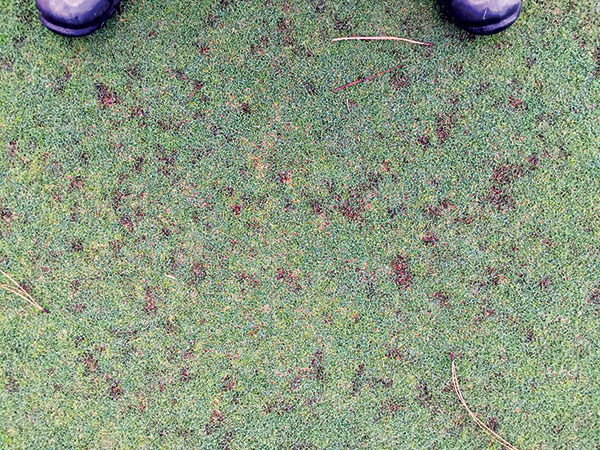
Severe Pythium blight on a bermudagrass green in winter 2015.
Control has been achieved with typical fungicides labeled for Pythium diseases such as mefanoxam, phosphonates, propamocarb, mancozeb and cyazofamid. However, little is known of the causal agents and when they are exerting their most damaging effects. One study at Clemson determined that P. myriotylum, P. arrhenomanes, P. aristosporum, P. rostratum, P. graminicola and P. vanterpoolii were present on bermudagrass roots during spring sampling, and that P. myriotylum, P. arrhenomanes and P. aristosporum were highly pathogenic to bermudagrass in growth chamber inoculations. Some of these Pythium species are the same as those implicated as major pathogens of creeping bentgrass roots, causing Pythium root rot. A study in Florida showed P. irregulare as a pathogen of bermudagrass encountered there during spring transition.
Although Pythium can attack bermudagrass at any time of the year, it’s most frequently observed and diagnosed as a pathogen during the fall, winter and spring, when bermudagrass is not vigorously growing. Pythium blight occasionally causes problems on newly sprigged bermudagrass during establishment when abundant fertilizer and irrigation are applied. But it can and does occur on well-established and older greens in cooler months, as noted. Excess moisture is a factor common to all Pythium diseases in any turfgrass, and that observation holds true when it occurs on bermudagrass.
One thing is certain. Superintendents in the Carolinas have learned to respect the role of Pythium as a major pathogen of bermudagrass during heavy rains in fall, winter and spring. And university scientists and others in the industry have learned also that Pythium can be quite damaging and deserving of research for biology studies and control options to develop best management practices.
In the meantime, when abundant and prolonged rainfall occurs, superintendents are well advised not to forget Pythium and to consider proactive application of effective fungicides.
References
Hendrix, F. F., W. A. Campbell, and J. B. Moncrief. 1970. Pythium species associated with golf turfgrasses in the south and southeast. Plant Disease Reporter 54:419-421.
Latin, Richard. 2011. A practical guide to turfgrass fungicides. APS Press. 270 pages.
Leslie, Mark. 2013. The ultradwarf revolution: Superintendents from the transition zone southward are sleeping better at night because of a sweeping change in bermudagrass cultivars. Golf Course Management. November. 81(11): p. 42-46, 48, 50, 52, 54, 56, 58.
Luc, John Eric, Canegallo, Alejandro, and Bruce Martin. 2005. Spring dead spot in bermudagrass greens in Argentina and South Carolina. Golf Course Management. September. 73(9): p. 92-95.
McCarty, Bert and Alejandro Canegallo. 2005. Tips for managing ultradwarf bermudagrass greens. Golf Course Management. June. 73(6): p. 90-95.
O’Brien, Patrick and Chris Hartwiger. 2014. Calculating costs confidently: A thorough analysis is a must when comparing operating costs between creeping bentgrass and ultradwarf bermduagrass greens. USGA Green Section Record. May 2. 52(9): p. 1-6.
Parker, Shane. 2005. Determining the Role of Pythium fungi in spring transition and summer decline in bermudagrass putting greens. M.S. Thesis, Clemson University.
Stiles, C. M., L. E. Datnoff, and P.A. Rayside. 2007. Pythium spp. isolated from bermudagrass during overseed transition in Florida and pathogenicity of Pythium irregulare on Poa trivialis. Plant Disease 91(10):1237-1244.
Whitlark, Brian. 2012. Nonoverseeded ultradwarf bermudagrass greens: faster, smoother, sooner. But managing them in the winter can be tricky. USGA Green Section Record. March 16. 50(6): p. 1-5.
all photos by: Bruce Martin









